“A Diabolical Concentration of Power”: How Home Rule Almost(?) Put Grapevine in Dallas County, 1933-1936
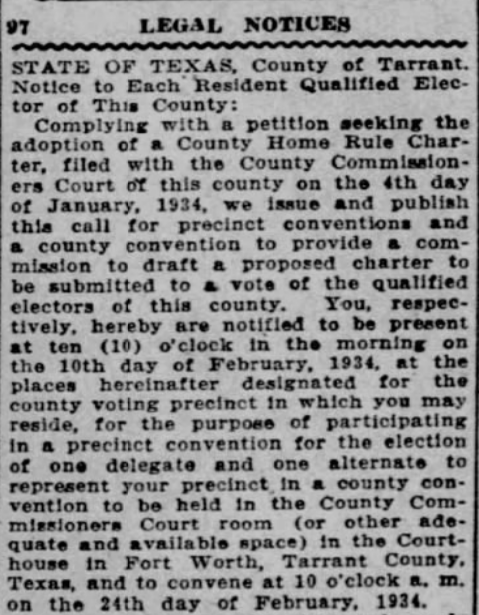
In February 1933 two plans for increased economic efficiency in the organization and working of county and municipal governments were pending in the Texas State Legislature. One was a revised Home Rule Bill presented in the Senate by Frank H. Rawlings of Fort Worth and in the House by R. Emmett Morse of Houston. This bill was originally presented by Walter Beck in 1931 but failed to pass. The second plan, presented to the House by Z. E. Coombes of Dallas, consisted of a resolution calling for the addition of a new section consisting of four paragraphs to Article 5 of the state constitution.
The Home Rule Bill focused on modifying Article 9 of the Texas state constitution, which dealt with administration of counties. Its primary purpose was to give home rule powers to counties with populations greater than 60,000. It would add Section 3, the home rule amendment, to Article 9 but it would only allow counties to create whatever organization best suited their fancy for carrying on their administrative affairs. It could not interfere with state sovereignty and public policy. The bill’s second purpose was to provide a way for cities to merge their governments with the county but only with consent of two-thirds of voters living in the governmental jurisdiction to be merged, and without consent of a majority of voters of county living outside that jurisdiction. To prevent domination by either urbans or rurals, urban and rural votes were to be counted separately and a majority of each would be required for a home rule charter to pass.
The Coombes proposal to amend Article 5, which dealt with included the following:
- Compensation of county and precinct officers with salaries instead of the current fee system
- Enlargement of managerial and controlling authority of Commissioners’ Court
- Abolishment of offices of Tax Collector and Tax Assessor and require Commissioners’ Court to appoint tax clerk to perform those duties
- Appointment of record clerk to supersede District and County Clerks and appoint Treasurer, Surveyor, and Public Weigher
The Texas House adopted the home rule resolution on May 2 and the Senate on May 12, 1933. Citizens could now vote on whether counties with populations of over 60,000 should have home rule, combine city and county governments, and effect other economies. The election would be held August 26, 1933.
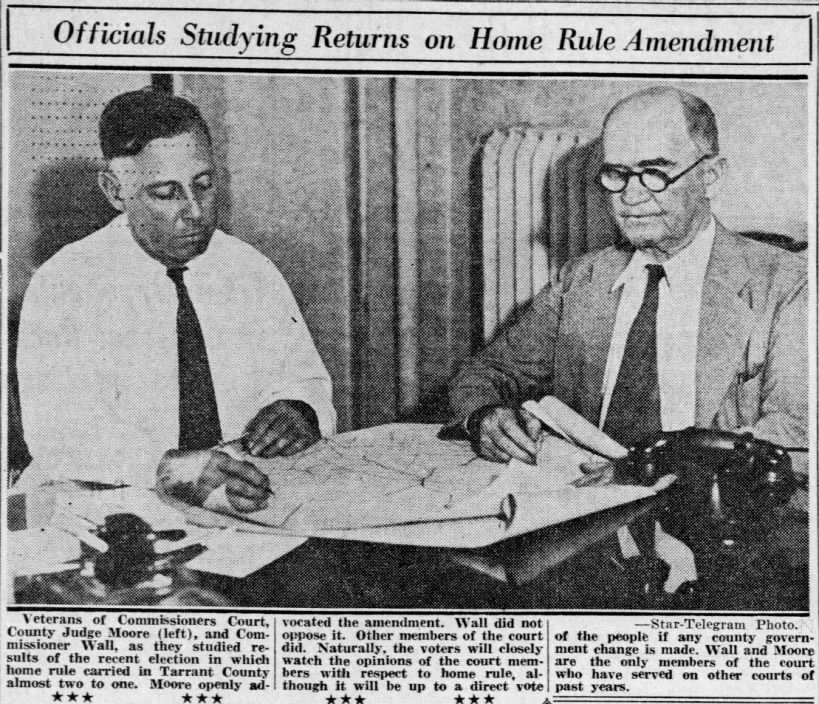
election results. Fort Worth Star-Telegram, September 4, 1933, p. 3.
These amendments became subjects for much public discussion in the months leading up to the election. County Commissioner Sandy Wall (Fig. 1), formerly of Grapevine but then living in Oakhurst, did not oppose the measure but was not active in the home rule campaign. He kept an open mind, saying he was ready for any measure that would benefit the county or the state.
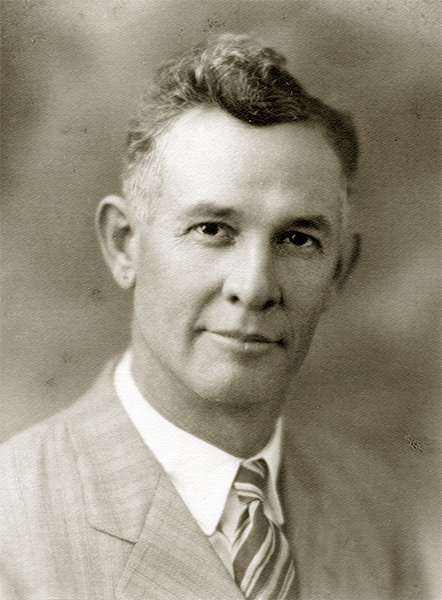
Grapevine.
Circling the Wagons
On August 3, 1933, anti-Home Rule petitioners, including Frank Estill of Grapevine (Fig. 2), former Tarrant County commissioner of Precinct 3, met in the Forty-eighth District Court in Fort Worth. The petitioners contended that the Home Rule Amendment would not result in more economy and efficiency; that it was intended to centralize government in the hands of a few; and that the officials would be put on civil service for life. They formed a permanent organization and decided on a “militant campaign” to make Tarrant County firmly against home rule. Several speeches were made denouncing the amendment, calling it a “diabolical concentration of power” and a “civil service in a different capsule so you can’t taste it when you swallow it.” Frank Estill was named president of this organization, which met on August 5 to draft a statement of its views. On August 19, one member of the group appeared at Arlington, one at Grapevine, and one at Mansfield to speak out against home rule. Whether invigorated by speech or already inclined to vote in that direction, Grapevine voters rejected home rule by a vote of sixty-five for and 199 against. The small vote cast was a result of non-payment of the poll tax and of some voters choosing not to vote. Tarrant County as a whole voted in favor by a margin of about two to one.
Two petitions were presented to the commissioners on January 5, 1934 (Fig. 3). The home rule petition asking the Commissioners’ Court to call the 106 precinct conventions was presented by a number of local individuals. George E. Nies, Jr., past president of the Fort Worth Real Estate Board, presented a petition of over 1,000 names. The commission accepted both documents the same day. One of the commissioners said the court would likely want to check the names on it but the county judge waived that formality. However, the court decided on January 8 to conduct an informal check.
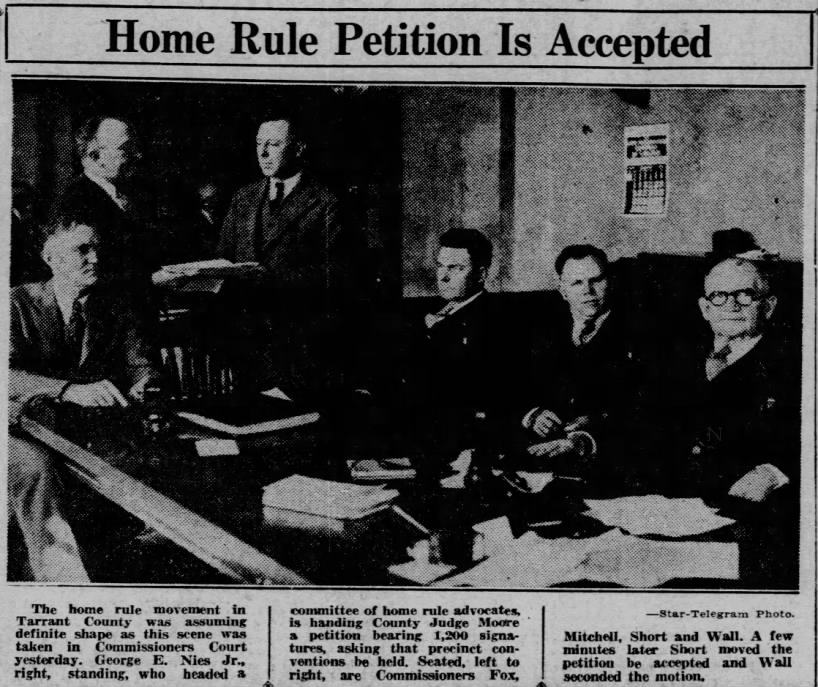
Fort Worth Star-Telegram, January 5 1934, p. 1.
The commission’s next steps for charter submission included election at precinct conventions of delegates and alternates to a county convention; selection at the county convention of a committee to draft a home rule charter; five regional hearings on the charter as drawn up by the commission; and a ten-day period for suggestions and revisions. After this a general charter election would be held. To be adopted the charter would have to get a majority vote in unincorporated subdivisions and incorporated towns and cities as separate units.
A Snag in the Process
The petition hit a snag on January 10 when a deputy county clerk checked the names on it and said that of the 600 out of 1,000 names checked, only about 300 were taxpayers on real property. The first 600 names also included an affidavit from a certified public accountant stating that they were qualified voters who also owned property. On January 11 five individuals vocally protested the calling of those conventions based on what they termed a faulty petition. They hinted that there were enough citizens in Tarrant County to throw the entire matter into court unless the petition procedure was followed to the letter of the law. One of the protesters was Mayor B. R. Wall of Grapevine, asserting that he represented the northeastern part of the county. He stated that he examined the petition and could not find a single qualified signer from that sector. The proponents insisted that the signers said, by their signatures, that they were taxpayers and that opponents would have to prove that they were not. January 15 was the last day for the commissioners to call the February 24 county conventions, and George Nies, the principal proponent, argued at the commissioners’ table that by law the commission was bound to call the precinct convention on January 15 and the matter was already on the court’s docket to do so. When he said that nobody had legally challenged the petition, Mayor Wall walked up and interrupted him. “I challenge the petitions and demand proof that the signers are qualified.” Nies shot back, “And we demand proof that they are not. Anybody can walk up here and say they are not qualified. Prove it.” The Fort Worth Star-Telegram called the opponents’ efforts “a veritable tempest in a teapot” and “a foolish waste of time.”
Auditors worked through the following seven days on the petitions. Nies vowed he would bring in additional voters if the checked numbers were less than 600. The clerk was able to verify 506, and Nies handed over 112 additional names to be legally added to the January 4 petition. Mayor Wall argued that the later petitions should not be considered as part of the original because neither the original nor the supplements contained enough qualified names unless considered collectively. However, the commission granted the petition on January 15. As printed in the Star-Telegram on January 25, the precinct convention would held on February 10 and the county convention on February 24.
Mayor Wall Continues the Fight
Undaunted, Mayor Wall continued his anti-home rule campaign in Grapevine. On February 1, 1934, he asserted in The Grapevine Sun that “in spite of newspaper propaganda, [home rule] does not appear to have any support in Grapevine.” He was adamant that “we must fight our own battles . . .” He called a meeting on Saturday, February 3 where “[s]ome interesting facts and figures will be presented.” About fifty businessmen and farmers attended and voted to make an active fight against the Home Rule Bill; the Grapevine Sun reported that “[e]very man in the house stood to his feet, indicating his opposition to the bill.” The mayor attended and spoke at another meeting at Carroll School on February 8 with Carl Yates.
On February 9 and 10 an anti-home rule convention caucus was held at the Grapevine Oddfellows Hall. Forty-nine residents were present and elected Mayor Wall Grapevine’s delegate to the convention, with Dr. Charles E. Walker as alternate. H. H. Yancey was elected secretary, M. A. Buchanan assistant secretary, and Robert Mullinax chairman. Interestingly, the Star-Telegram reported that “a large crowd of voters . . . jammed the Odd Fellows Hall” but that in almost all other precincts attendance was light, especially in cities. The mayor entertained many visits and inquiries from home rule delegates on February 11. For the next couple of weeks he was busy conferencing with other anti-home rule advocates in Grapevine and Fort Worth.
Each side accused the other of misrepresenting that side and its intents. A rumor had been recently circulating that anti-home rule advocates, who claimed majority support in the county, were trying to adjourn the county charter convention on February 24 without even electing a charter commission. Mayor Wall’s February 12 statement that “Home rule is blown up” added support to that rumor. “’I notice,’” he observed, ‘that [home rule proponents] plan to start an educational campaign. I guess everybody against it is a heathen.’” However, the anti-home rule crowd was said to have plans of their own to nullify the whole procedure on the grounds that conventions were not ordered within the required ten-day period and the illegality of the previously mentioned petitions. They were said to be considering electing an “anti-chairman” who would appoint a nominating committee that would recommend dropping the home rule movement or writing a new charter making few if any changes, thus zeroing out the entire matter.
On February 24, 1934 the county home rule convention met at the Tarrant County Court House in Fort Worth from 10:00 a.m. to 6:30 p.m. Mayor Wall observed that “[o]ur crowd [was] in complete control.” That morning Mayor Wall nominated fellow home rule opponent W. D. Davis for the position of convention chairman. Davis was elected over proponent Thomas Fletcher by a vote of sixty-eight to twenty-nine. He then appointed a five-man nominating committee composed of his supporters (including Mayor Wall) which would create a list of thirty names from which eleven commission members were chosen later that day; the remaining four were chosen on March 3. Mayor Wall was also named to the charter drafting commission (Fig. 4). He and other supporters said they were as much in favor of better government as their opposition. The convention had to move to a larger courtroom because none of the spectators would relinquish their seats to the delegates.
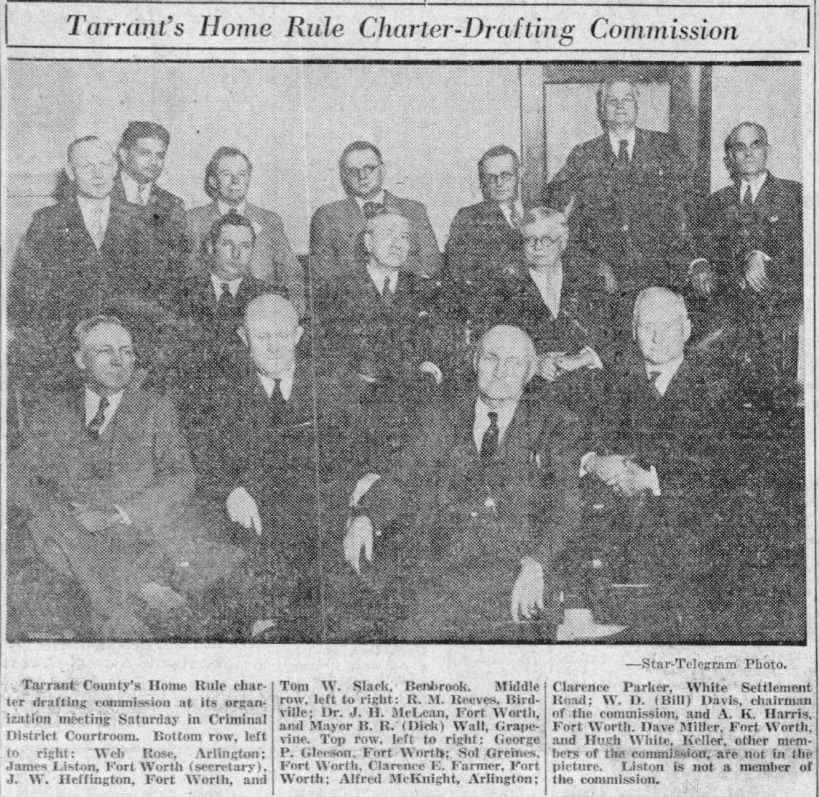
is seated on the right in the middle row. Fort Worth Star-Telegram, March 5, 1934, p. 1.
In an interview in the Fort Worth Press on March 2, the mayor declared that “‘If some way can be devised to reduce taxes and at the same time provide protection for rural people against encroachment by the city folks—now and hereafter—I’ll be for it.’” He said he was willing to hear anyone and take all suggestions back to Grapevine for a decision. The committee had six months to present a charter to Tarrant County voters. Its first public meeting was held on March 12, but the response was meager. Members decided to make phone calls to home rule proponents and invite them to attend the following meeting on April 9. After hearing three speakers give suggestions that day for improving county government, the committee adjourned until April 30, when it voted to begin work on the charter on May 4. A provision was included on May 4 that if the charter passed, it would not go into effect until January 1, 1937.
Countdown to a Home Rule Charter
On May 11, the commission turned in its written suggestions for improving county government. It also created a five-member subcommittee to work on completing the charter within thirty days. As required by the home rule law, the first draft had to be presented within 180 days of its appointment. This occurred on July 28. The charter would abolish the fee system in favor of flat salaries, limit salaries of county officials and employees, and eliminate three minor county offices, among several other things. The recently completed draft was read to the charter commission on August 7, but it was not until August 28 that twelve members of the commission signed off on it due to revisions on various sections. Mayor Wall was one of three signers who did not recommend adoption. The charter was published in the Star-Telegram on September 5, and five public hearings were scheduled, one of which would be in Grapevine.
The first public meeting was held at the Odd Fellows Hall in Grapevine on September 26 with only twenty persons attending, and twelve of them were from Fort Worth. When asked, just two Grapevine residents simply said, “’We don’t want it.’” The meeting was over in five minutes. Afterward, Mayor Wall took the Fort Worth residents on a tour of Grapevine’s canning factory. He explained that the factory operated twenty-four hours a day canning vegetables on a share basis for Grapevine and vicinity.
Turnout for the four required public hearings could only be seen as dismal, ranging from no attendees to twenty, and with only one suggestion made. At the final home rule commission meeting on October 12, the charter was adopted and sent to the Commissioners’ Court for a decision on whether to hold an election. The subject was a moot point for Mayor Wall, who reiterated his opinion that the original petitions asking for an election were invalid.
The Home Rule Charter Commission’s duties ended on October 16, 1934 when nine of the fourteen members present signed the charter. The election was held on November 4. The home rule city charter measure passed by 2,296 to 2,036; the home rule city terms of office also passed 2,445 to 1,908.
Not Over Yet?
One would think that was the end of the home rule issue, but for at least one Grapevine resident, it wasn’t.
Grapevine farmer and businessman Carl Yates had made news all over Texas in 1930 by barricading the part of the new Highway 121 that divided his Grapevine farm property and guarding it with a shotgun because he believed he was not paid fairly for his trouble, was now calling for Grapevine to secede from Tarrant County and become part of Dallas County.
On April 16, 1936, Yates claimed a “’whispering campaign’” to move Grapevine into Dallas County was being conducted by Grapevine residents. He also claimed that “Grapevine would vote 3 to 1” to move the Dallas County line two miles further west. “My family has lived in Grapevine for seventy-seven years. We broke with Tarrant County when it tried to put home rule over on us. They wanted to make us share their tax burdens, but we fought it and Dallas County helped us in the fight.”
“The interest of Dallas people in our town is much greater than that shown by Fort Worth. We believe there is a better form of government, a better road system[,] and a better county . . . than in Tarrant County.” He also declared that since Northwest Highway was constructed most Grapevine people went to Dallas, and that more Dallas people came to Grapevine than Fort Worth people. Also, he averred that other local businessmen were looking to petition the state legislature to put Grapevine inside the Dallas County line.
After the Highway 121 and home rule happenings, Yates said that the last straw was an argument with his brother-in-law Commissioner Frank Estill over the price of ten acres Yates sold to the county for right-of-way for the Arlington-Grapevine Road. Yates claimed the county was actually taking fifteen acres but only paying him for ten.
Mayor B. R. Wall observed in his diary entry of April 20 that there was a “[c]onsiderable row biding about Carl Yates wanting to put Grapevine in Dallas Co.,” but the mayor said he had no grievances against Fort Worth and had not heard a single complaint about how Tarrant County treated Grapevine. He also said he preferred Fort Worth’s more welcoming attitude regarding his visits to that city and to Dallas.
As far as can be determined the threatened secession of Grapevine might also be called a tempest in a tea pot, since the subject did not surface again publicly. In fact, on August 5, 1969, Section 3 of Article 9 of the Texas Constitution providing for county home rule charters was repealed under House Joint Resolution 3 “[b]ecause of its poor draftsmanship, vagueness, and irreconcilable conflict of some its provisions with other, more specific provisions of the Constitution.” In 1948 the Texas Attorney General declared it unconstitutional, that “whatever the merits of home rule, this does not provide it, and it seems there are no . . . desires for such in Texas.”


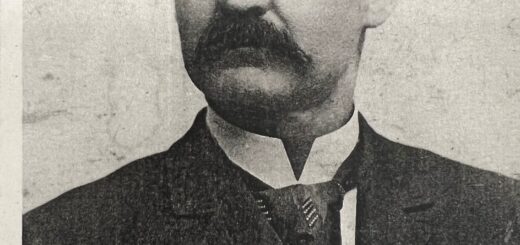
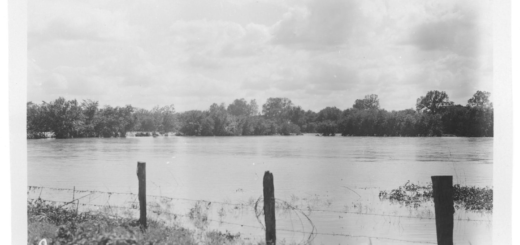
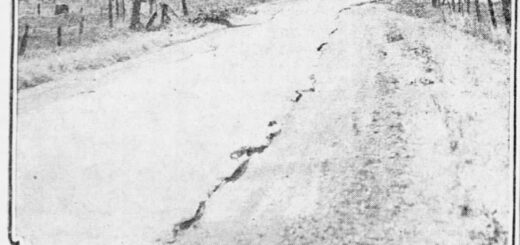
Recent Comments